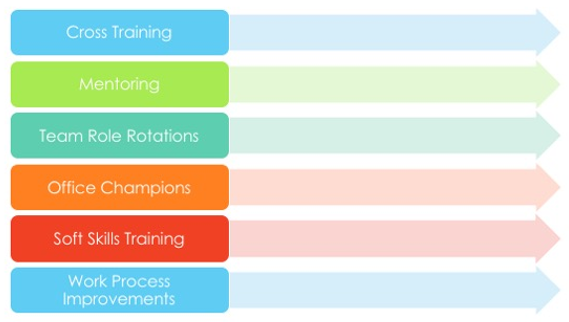Welcome to
Lead Motivate and Inspire your Dream TeamGuide a team the right way to achieve your business goals
Module Two
Build Your Team’s Value through Learning Opportunities
Hiring and training employees, whether full-time or freelance contractors, takes a great deal of time, effort, and resources. Because of this great investment, you want to keep the people you hire happy and encourage them to continue developing their skills. The best way to do this is to offer learning and development opportunities to your team. This not only allows you to retain team members, but also leads to their development and growth, which makes them even more valuable to your organization.
Luckily, learning and development don’t have to be a costly endeavor. For small businesses and solo entrepreneurs, there are plenty of impactful and inexpensive ways to inject learning into your business culture.
Some of the key learning opportunities that impact all team members include employee onboarding activities, ongoing skill/knowledge development, transitioning to new roles, soft skills, and other types of initiatives for learning.
Onboarding
At a minimum, someone in your organization should be appointed with the task of orienting and educating new team members – also known as ‘onboarding’. This can be as simple as having a check-in with them once a week for 30 minutes on Skype, or an in-person chat to see how they’re doing and answer questions.
If you have trouble retaining team members, having a mentor can help a great deal. With a mentor, new hires feel more comfortable. They have someone whose role it is to answer questions and help.
It is common for small business owners to handle onboarding themselves, especially when teams are small. As you grow, it’s better to designate another team member with this task or rotate team members to fulfill this role.
Ongoing Learning and Development
If you are working with professionals, they may need to add new skills to their repertoire from time to time to keep up their certifications.
However, all your team members will benefit from developing different skills or improving ones they already have. Before the advent of the internet, this meant sending employees to costly conferences or paying tuition at expensive institutions.
Today, there are many free professional development training programs that you can offer your team. EdX and Coursera both offer free and paid versions. Generally, you can view and access any course materials for free. Certificates are reasonable, generally around $50. You can offer to pay for the certificate you’d like your employee to acquire.
Lynda.com is another site which has a huge range of training programs your team members could take advantage of. There are even discounted options for training more than 5 people.
Transitioning to New Roles
Depending on the size of your team, you’ll want to carefully consider how to track team members in order to advance them to new roles and responsibilities. Shifting roles and responsibilities leads to happier and generally more successful employees. Early on, identify potential leaders and let them know of your plans to promote them.
Here are some strategies you can use for both in-person and virtual teams.

Cross Training: If you have a small team, you may want to consider cross training. This is easy and inexpensive to implement, and it can help to keep your team motivated to stay with you.
For example, let’s say that you have two team members. One is overseeing one line of business, such as educational institution sales, and the other is managing private sector sales. You can create a cross training program where they shadow each other for a month or two to learn new skills. “Shadowing” could be something as simple as listening in on sales calls or attending meetings with them. They can learn skills through the training that they can use in their own role. They also may be able to switch roles at a future time, but reassure the people being shadowed of their job security.
Mentoring: Set up a mentoring program for team members who hope to be promoted to new responsibilities. This doesn’t have to be someone inside your organization. It could be a coach or mentor from outside as well. For example, if your team member wants to shift from marketing to sales, ask a friend or colleague who is a sales expert to eat lunch with them on a regular basis. Pay for lunch since it goes toward enriching your business. And don’t forget to reciprocate by mentoring someone yourself!
Team Role Rotations: Another idea is team rotations. This is where you rotate members through various roles. In today’s economy, and especially in small business, workers need to wear many hats. This is good training for the modern economic environment. It also keeps team members more interested and engaged when they can experience many different roles.
For example, you might have a marketing project that wrapped up early. You could then have the team member in charge of the project spend a day or a week supporting another project in order to obtain good cross functional experience.
Office Champions: Consider having a rotating office champion who, when champion, gives a presentation lunch to teach other team members about their specific role and what they do. This gives team members a chance to learn what each other member does in detail. You can make this fun by turning it into a party, a potluck, or coffee time.
Soft Skills Training: Soft skills are essential for the entrepreneurial mindset. Implementing soft skills training helps your team members improve and nurture these skills. This is even more important if you’re trying to change your company culture.
“Soft skills” refer to a combination of people skills, social skills, communication skills, and career attributes. A good way to do soft skills training is to pair up one team member who needs help with another team member who is better at that particular skill. Give them problems to solve together or tasks to achieve. EdX also offers some great free and low-cost courses on specific soft skills, such as communication.
Work Process Improvements: As part of your coaching and skill development, you can assign teams a challenge to solve. For example, communication and collaboration can sometimes be problems for businesses. Offer a contest for your team to solve a particular challenge you’re facing. It could be something as simple as starting a Slack channel or implementing Google Drive across the organization to make your operations run more smoothly.
Activity:
- From the ideas presented in this module, pick one or two things you can implement as part of your Learning and Development program.
- For each of your selected ideas, identify:
- Who will be involved in the program?
- If it requires an expense, what will be your budget?
- When will you implement the program
A Word
From Tamara
As an entrepreneur myself I completely understand the stress, anxiety and frustration around launching or growing a business. I also know the rewards and life style change the hard work can provide you if you stay focused. I am here to inspire and motivate you to push forward. The fact that you’re investing in your business education let’s me know you’re in this to win. Rest assured I’m here to help you…. These courses are set up to help you understand the basics. To dig deeper into your specific plan of action we will discuss where you are, where you want to be, eliminate any blocks preventing you from getting to the next step and create an action plan.

Our superpower is making you a superhero.

